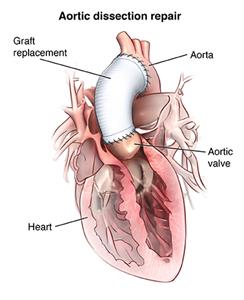Dr Anbarasu's Dairy - Aortic Dissection
Aortic Dissection
Aortic Dissection is a life threatening emergency condition where a tear happens within the layers of the great blood vessels which arises from the heart - The Aorta. If not properly diagnosed within the first few hours, the patient usually succumbs to the disease.
The risk to life (mortality rate) is 21% in 24 hrs, 38% in 48 hrs, 62% in 7 days and 74% in 14 days. That means, if a proper diagnosis is not established and treated properly, 1in 5 patient doesn't survive in the first 24 hours, one in three patients succumbs in two days, 2 out of 3 patients within one week. Once an Aortic Dissection occurs, its like a ticking time-bomb.
The symptoms of an Acute Aortic Dissection is severe chest pain spreading to the back. The severity of the chest pain is more than a Heart Attack (Myocardia Infarction). Some patients may develop associated breathing difficulty. The onset of symptoms may be severe and quite progressive. Some people may develop abdominal pain or stroke.
Patients may also have severe sweating, abdominal pain, confusion, loss of vision or fainting.
Acute Aortic Dissection is commonly mis-diagnosed as a Heart Attack and treated. An ECHO done in the casualty usually arises suspicion. So all patients received with chest pain in the Casualty or Emergency Room (ER) should have a screening ECHO to establish a diagnosis, before they are rushed to the Cath Lab.
Who are the patients who are prone to develop Acute Aortic Dissection?
People with Uncontrolled Hypertension (High Blood Pressure), People with congenital syndromes like Marfan's Syndrome (These people are usually very thin and tall). People with conditions like Bicuspid Aortic Valve, other rare disorders like Ehler Danlos syndrome, Turner's Syndrome and occasionally high intensity weight lifting body builders are prone for Aortic Dissection
What happens if Aortic Dissection is not diagnosed or treated?
There is a risk to life, and aortic dissection is like a ticking time-bomb. Patients may die due to rupture of the dissectionion flap, severe heart failure due to sudden leak of the Aortic Valve (Acute severe Aortic Regurgitation) complications like stroke or mal-perfusion of the blood vessels supplying the intestines or kidneys.
Rarely patients may survive the initial insult of Aortic Dissection and come up for an intervention later.
Are there different types of Aortic Dissection?
There are two types of Aortic Dissection(Stanford classification). Type A dissection when the dissection rises just as the great blood vessel arising from the Heart - Aorta involved and Type B when the dissection as the Aorta turns into the chest to supply other organs.
As a rule, Type A Dissection is treated as a surgical emergency and Type B is treated conservatively initially. Type A Type B






Comments
Post a Comment